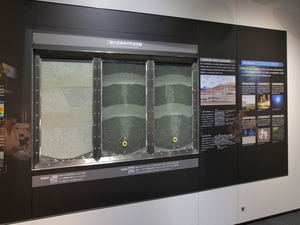Nagoya City Science Museum
TOP > Exhibition Guide > Keyword Search > Starting with "G" > Global Warming > Carbon Dioxide Underground Storage
Carbon Dioxide Underground Storage



Purpose of Exhibition
To control the rise of the atmospheric carbon dioxide concentration, not only reducing the fossil consumption and expanding the absorbing source by reforestation, but also CO_ caputure and storage technologies (CCS) are drawing attention as a global warming countermeasure. It's said that CCS is the most practicable of these CO2 countermeasures. How is it possible to store gas underground? This exhibit of the geological layer models with 2 kinds of glass beads, 1mm and 2mm in diameter, as differently permeable layers of porous sediments visualize the behavior of gas injected in aquifer.
Additional Knowledge
[Observing the Injected Gas Moving]
The gas injected into geological layers that filled with water (aquifer) tries to rise by buoyancy because it is lighter than its surroundings. However, you will notice that the bubbles remain trapped in the particle interspaces of deposit material (residual gas trapping), because the bubbles cannot grow in the narrow interspaces, and the buoyancy isn't large enough. This is similar to the confinement of air in a sponge sunk in the water.
However, since the gas is injected continuously, the bubbles rise and thread between particle interspaces of deposit material that connect several layers. It is understood that in coarse-grained geological layers, the bubbles rise easily and stay under the fine-grained geological layer (impermeable layer). In particular, the bubbles tend to stay under the part (anticline) that the geological layer curves above (structural trapping).
If we keep injecting gas, the gas gathers in such structures, and it becomes more buoyant until suddenly it rises through the impermeable layer (breaking it). In other words, it can be said that there is a limit in the amount of gas we can store in such a place. However, it is understood that not all of the gas will escape, and a constant amount keeps being trapped.
[Stored Carbon Dioxide Dissolves with Time]Since carbon dioxide is soluble in water, this amount becomes ions and move to isolated in the underground water (solubility trapping), then settles as minerals (carbonate) such as calcite (mineral trapping). Then, it never returns to the atmosphere.
Thus, there are four trapping mechanisms for the geological storage of carbon dioxide: residual gas trapping, structure trapping, dissolution trapping and mineral trapping. In this order, it can be stored underground for the long term and time for trapping also increases. Then, a combination of each mechanism as a storing method is considered while taking into acount the geologic structure.
[Store the Carbon Dioxide Where Fluid Originally Stayed]
There are several other ways that are also being considered other than injecting in the aquifer (geological layer that is filled with underground water) as a method of carbon dioxide capture and underground storage. The places where fluid (liquid and gas) such as oil and natural gases are stored originally are thought to be able to store carbon dioxide easily. Therefore, using the method of injection while excavating oil and natural gas is certainly conceivable. It is an idea that activates resource recovery and storage at the same time as pressing carbon dioxide to recover oil and natural gas effectively in oil mines and natural gas fields, where collection quantity is decreasing. Thus, effective and safe storing methods alongside subsurface geology and structure has been studied by researching storing mechanisms.
Though the carbon dioxide capture and underground storage is not the fundamental solution to global warming, it is thought to be an effective method to reduce carbon dioxide emission in the foreseeable future. Because technology accumulated byoil digging technology can be applied, it may be the most practicable and immediately effective technology. Therefore, the development of carbon dioxide underground storage technology is advancing through a combination of the boring process and conducting model experiments.
Cooperation:
Yasuhiro Yamada (Kyoto Univercity)Article by Shoji Nishimoto, curator
